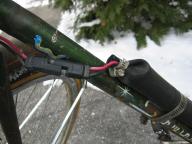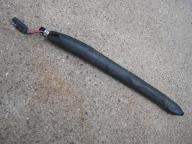




System no. 2 is a 6 volt system and uses a standard bicycle headlight. I replaced the lamp with a higher wattage one. One of the lessons from System no. 1 was to always include a fuse close to the battery. The battery consists of five "C" size nickel-cadmium cells soldered end-to-end. The fuse holder is from a radio store. The switch is a push-on/push-off type from the lighting department of the local hardware store.
The battery, fuse holder, and switch are all contained in a length of 1-3/8 bicycle tube, folded over at the bottom, held shut with a hose clamp at the top, and mounted to the down tube with hose clamps. The battery assembly is connected to the lighting system with a two-conductor weatherproof connector from an auto supply store.
The taillight (not shown) is a standard truck side marker light. I removed the bulb and replaced it with three bright red LEDs and a simple voltage divider to run from 6 volts, all held in place with hot glue. I built this system in 1990, when bright red LEDs were first available (at a dollar or more each!) and you couldn't yet buy them at the auto supply shop.
I used this system from 1990 to 2003 on my main bike, a 1969 Schwinn Racer three-speed. Total cost was around $25, most of it for the battery.
This is my first 12-volt system. The goal here was to make sure I could see and be seen.
The headlight is a 55 watt halogen "poacher" light from an auto supply store, slightly brighter than a standard car hi-beam headlight. The front running light is an amber bullet-nose marker light. The taillight is a four-inch round truck taillight from a truck stop. It has a dual filament bulb for separate running and brake lights.
The horn is an aftermarket replacement hi-tone intended for large GM cars like Buicks and Cadillacs.
The front and rear running lights are controlled by one switch on the control panel, and the headlight by the other switch. The horn is activated by a replacement horn button from an auto supply store.
The brake light is activated by a microswitch mounted to the side of the right (rear) brake lever.
The battery (not shown) is a standard 12-volt 8Ah gel-cell of the type used in emergency lights, fire alarms, and phone sytems. I never came up with a good mounting system for the battery.
I built this system in 1992 and it is still in use on my 1954 Raleigh. Total cost was around $60.
System no. 4 was inspired by A. Maitland Bottoms's system. See his web page for more details on building one of these. It uses a PVC pipe coupling from the plumbing department of the local hardware store as a mount for a MR-16 12-volt bulb intended for hi-intensity lighting. These come in various types. I used a 20 watt. This is a clever trick that I didn't think of, apparently some guy named Ron came up with it.
I need my systems to be weather proof, so I used siliconized acrylic latex bathtub caulk to glue a cap to the end of the coupling. I was a little concerned about cooling with such a small, sealed enclosure, but it hasn't been a problem. I used the female pins from a .062 inch Molex-type connector to fashion a socket for the bulb, and recycled the power switch from System no. 2 (above).
I later discovered a commercial alternative that is chrome plated and looks like it should work, although it does not have a built-in power switch. Optronics QH-7CC, available from J.C. Whitney as ZX490430B.
The taillight is an LED marker light from an auto supply store. I used metal strapping to mount it to the rear of the luggage rack. This strapping is available at the hardware store for hanging ducts and pipes.
The battery is a 12-volt 4Ah gel-cell. I'm no good with battery mounting so I just toss it in my saddle bag. Batteries need to either be firmly mounted to the bike frame or easily removable.
I finished this system in 2004 and it is currently in use on my 1969 Schwinn Racer three-speed. Total cost was around $45, mostly for the battery.
I'm using a MR-16 bulb now but that's less than ideal because it's got a round pattern. What's really needed is a 20 watt sealed beam bulb the size of a MR-16 but with a keystone pattern like a car headlight for under $20 with waterproof fixture.
Of course some people like the round MR-16 pattern because it puts a lot of light into oncoming drivers' eyes, and I can't really argue too much with that.
Jim Rees